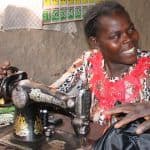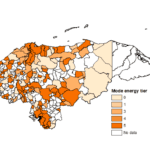Breaking the Catch-22 of Poverty: What’s Next for the Graduation Model?
The graduation approach has come a long way. A sequenced set of interventions that combines elements of social protection, livelihood development and financial services, the approach has expanded globally over the past decade, as rigorous research has demonstrated its ability to move ultra-poor families into sustainable livelihoods.
But graduation is a time-, labor-, and cost-intensive model. Trickle Up was one of the early implementers of graduation programs, through a pilot sponsored by CGAP and the Ford Foundation. Like many organizations that implement the model, it has continued to expand its graduation work, while working to identify ways the program can increase cost-effectiveness and scale.
A Brief Recap
The graduation approach’s central insight is that a person perpetually trapped in survival mode cannot focus on anything but the here and now. Even before behavioral economists called this “depletion” or “scarcity,” Trickle Up recognized the need to break the catch-22 of extreme poverty: People caught in that trap remain in extreme poverty because they cannot build a livelihood, and they cannot build a livelihood because they are constantly overwhelmed by the crises that extreme poverty and multiple vulnerabilities create.
That’s why the graduation approach leads with consumption support (either actual food or the money to purchase food) to allow families the “luxury” of the time and energy to consider longer-term issues, especially livelihoods development. The graduation approach then helps the person identify an appropriate livelihood based on her interests and aptitudes and on market conditions, and then transfers cash or an asset in support of that livelihood. The asset might be a pair of sheep or goats if the livelihood is animal husbandry. Or it might be funding to purchase a start-up inventory to stock a shop if the livelihood is shopkeeping – or beekeeping equipment, or many other possibilities. When Trickle Up asked Maria Diego, a graduation program participant in Guatemala, how she would invest her seed capital, she knew right away: “I told them I could make chocolate, so for my business, I invested all $136 of my seed capital in cacao to purchase and resell in another community.”
The Importance of Coaches
A defining characteristic of extreme poverty is isolation. It is not uncommon for extremely poor households to be socially (and often physically) cut off from the wider community by poor transportation and communications infrastructure, denying them economic opportunity and even basic services. For example, many extremely poor communities do not take advantage of social protection programs—meant for them—because they literally do not know that such programs exist, much less how to access them.
To address the economic and social isolation faced by extremely poor communities, coaches engage participants at an individual level to build their confidence and basic financial education. Participants start by learning about savings and livelihood planning. These plans are an important means by which participants and their families conceptualize and set goals for their future. Coaches also help families obtain government benefits, such as health services. As participants engage in their livelihood activities, coaches visit regularly to ensure they are progressing, to provide “just in time” coaching for critical milestones in their livelihoods plans, and to help with any needed troubleshooting. This steady presence and positive reinforcement build participants’ confidence and skills.
As one participant from West Bengal noted, “When the coach first came and talked to us about savings, we didn’t know how he thought poor people like us could save. But we trusted him so we listened, and he showed us how we could begin saving.”
Government Involvement: Trickle Up’s Experience
Having participated in the CGAP-Ford Foundation graduation pilot in the state of West Bengal, India, Trickle Up secured funding from MetLife Foundation to include lessons from the West Bengal program into demonstration projects in two other Indian states: Odisha and Jharkhand. These projects caught the attention of policymakers, and both state and national officials from the National Rural Livelihood Mission (NRLM) visited to see the projects firsthand. After careful analysis and much discussion, Trickle Up and the state agencies of NRLM partnered to incorporate the graduation approach into government policy implementation in both Odisha and Jharkhand.
These efforts focused on particularly vulnerable tribal groups. Like other national governments, India’s has found that the needs of its poorest citizens are significantly different from those of even the slightly better-off poor. Trickle Up’s work in Odisha and Jharkhand initially demonstrated the graduation approach through work with 1,800 participants. It is now expanding among the bottom 10 to 15 percent of the population, the segment which has historically proven the hardest to reach effectively – and consequently, the one that has historically been left behind.
Learning from Each Other
Trickle Up gained a wealth of experience from participation in the CGAP-Ford Foundation pilot and from its subsequent adaptations in Odisha, Jharkhand and other Indian states, Latin America, Vietnam, Bangladesh, and six West African nations. It provides expertise to key actors from local implementers, regional and national government ministries, and multilaterals like the World Bank.
Given this portfolio of technical assistance partnerships with governments and large agencies across the world, Trickle Up is in a strong position to facilitate learning between different government programs, and has found that peer learning between those responsible for the design and implementation of programs at the national and local levels is very fruitful. Every year, the organization hosts or facilitates at least two of these types of events. Some involve learning visits, in which key government officials visit the implementation of a program in another country or region that is tackling the same kinds of challenges they face. Others might involve convening roundtable discussions, where governments share their challenges and learnings and discuss their approaches.
For instance, in December 2017, Trickle Up co-hosted a roundtable discussion in Mexico City in which Indian policymakers had a chance to discuss their programs with peers from Latin America, and visit a site to see the implementation of the PROSPERA national social protection program. This meeting was also attended by representatives of the World Bank and other NGO leaders in graduation. Through the sharing of challenges and learnings, the roundtable arrived at recommendations for scaling the graduation approach in social protection and cash transfer programs.
Similar progress was made in November of 2016, when delegations from Zambia, Burkina Faso and Mexico visited Trickle Up’s partner graduation program in Jharkhand, India.
An Evolving Model
Seeing the graduation program in action and being able to discuss it with peers from across the world led to interesting policy adaptations, particularly around the important component of coaching. As noted above, the presence of coaches – who provide graduation participants with an individualized range of both practical and moral support – is an important ingredient in the graduation approach’s success. It is also among the hardest to scale. The ideal coach possesses an unusual mix of hard technical skills and soft interpersonal ones; he or she must also be someone with a personal commitment to working with the ultra-poor. People with that ideal profile are difficult to find in critical mass, so the coaching component has been one of the main focuses of experimentation as government-led graduation programs seek to achieve mass-scale outreach.
For example, Trickle Up’s partners in the Indian government have been pursuing what they call the “community resource person” – or CRP – model. This approach identifies individuals in the local community with the necessary attributes (basic literacy, availability to work, desire to learn) and then provides training and materials so that these people can deliver coaching. The CRP model fulfills two important goals. First, it delivers the coaching component for graduation participants. Second, it is building the human resources skills base in local communities in a way that would not happen if coaching resources were brought in from the outside.
During the November 2016 study tour, the representatives from Burkina Faso were impressed by the CRP model they saw in India, and they are adapting it into their policy outreach in partnership with Trickle Up and their National School for Social Workers.
Diverse Contexts, Diverse Needs
But different countries are interested in different things. For example, the Indian policymakers who participated in Trickle Up’s roundtable in Mexico City last December wanted to explore what it would take to deliver coaching at the household level, rather than via the self-help groups that are the current locus. And Latin American policymakers have expressed interest in ensuring that their graduation programs are truly participatory. It’s important that participants chart their own pathways out of extreme poverty, but what that means operationally in the context of a graduation program is a topic ripe for exploration. In Vietnam, the question is how to tailor graduation to the needs of that country’s huge youth population. In Bangladesh, it’s how to use graduation to adapt to risks created by climate change. Over the next three years, Trickle Up will be testing, learning and sharing what it learns from its work in Mexico, Vietnam and Bangladesh.
Overall, however, there is emerging consensus about the necessity of the CRP model. Identifying and training coaches will be one of Trickle Up’s focus areas going forward. Policymakers are also especially interested in questions of accountability now that public funding is involved. How can they ensure that graduation programs remain accountable to the taxpaying public – and to the people they serve? Earlier randomized controlled trials established the efficacy of the “classic” graduation model. The task now is to learn what works – and how, and why – as graduation classic is adapted to achieve scale and sustainability through various government policies across the globe.
Evelyn Stark is assistant vice president for Financial Inclusion for MetLife Foundation, a NextBillion partner.
Jaya Sarkar is Trickle Up’s vice president of Program Quality and Innovation.
Photo courtesy of Trickle Up, taken from a video on their website.
- Categories
- Impact Assessment




